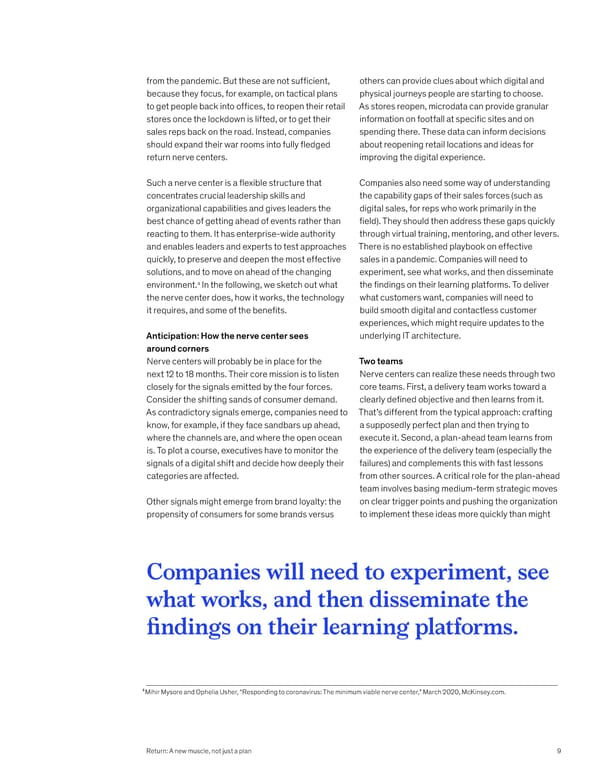from the pandemic. But these are not sufficient, others can provide clues about which digital and because they focus, for example, on tactical plans physical journeys people are starting to choose. to get people back into offices, to reopen their retail As stores reopen, microdata can provide granular stores once the lockdown is lifted, or to get their information on footfall at specific sites and on sales reps back on the road. Instead, companies spending there. These data can inform decisions should expand their war rooms into fully fledged about reopening retail locations and ideas for return nerve centers. improving the digital experience. Such a nerve center is a flexible structure that Companies also need some way of understanding concentrates crucial leadership skills and the capability gaps of their sales forces (such as organizational capabilities and gives leaders the digital sales, for reps who work primarily in the best chance of getting ahead of events rather than field). They should then address these gaps quickly reacting to them. It has enterprise-wide authority through virtual training, mentoring, and other levers. and enables leaders and experts to test approaches There is no established playbook on effective quickly, to preserve and deepen the most effective sales in a pandemic. Companies will need to solutions, and to move on ahead of the changing experiment, see what works, and then disseminate environment.4 the findings on their learning platforms. To deliver In the following, we sketch out what the nerve center does, how it works, the technology what customers want, companies will need to it requires, and some of the benefits. build smooth digital and contactless customer experiences, which might require updates to the Anticipation: How the nerve center sees underlying IT architecture. around corners Nerve centers will probably be in place for the Two teams next 12 to 18 months. Their core mission is to listen Nerve centers can realize these needs through two closely for the signals emitted by the four forces. core teams. First, a delivery team works toward a Consider the shifting sands of consumer demand. clearly defined objective and then learns from it. As contradictory signals emerge, companies need to That’s different from the typical approach: crafting know, for example, if they face sandbars up ahead, a supposedly perfect plan and then trying to where the channels are, and where the open ocean execute it. Second, a plan-ahead team learns from is. To plot a course, executives have to monitor the the experience of the delivery team (especially the signals of a digital shift and decide how deeply their failures) and complements this with fast lessons categories are affected. from other sources. A critical role for the plan-ahead team involves basing medium-term strategic moves Other signals might emerge from brand loyalty: the on clear trigger points and pushing the organization propensity of consumers for some brands versus to implement these ideas more quickly than might Companies will need to experiment, see what works, and then disseminate the findings on their learning platforms. 4 Mihir Mysore and Ophelia Usher, “Responding to coronavirus: The minimum viable nerve center,” March 2020, McKinsey.com. Return: A new muscle, not just a plan 9
 What Now? Page 10 Page 12
What Now? Page 10 Page 12